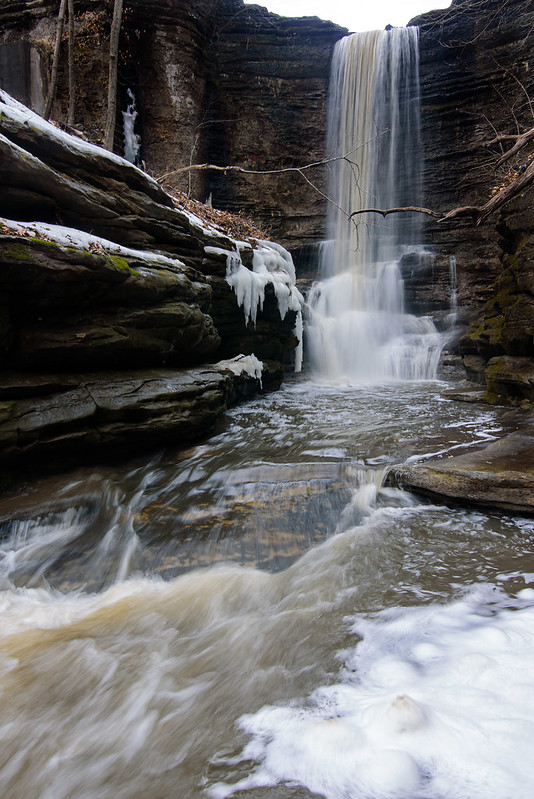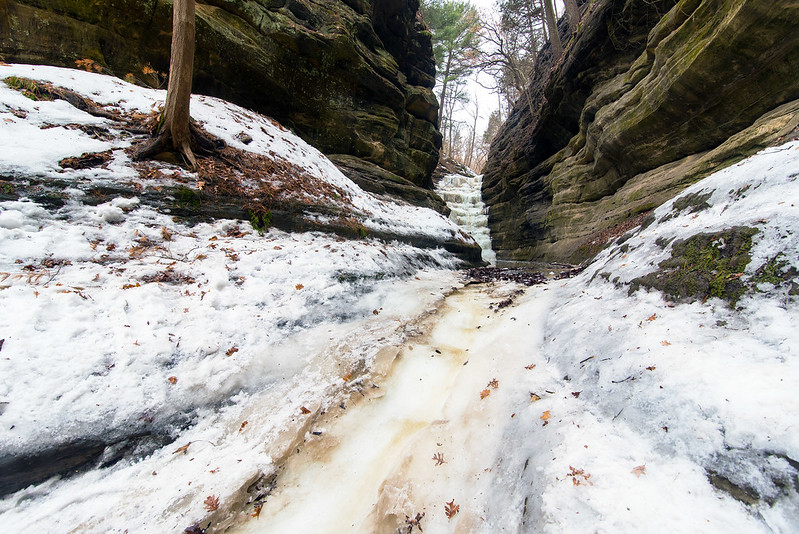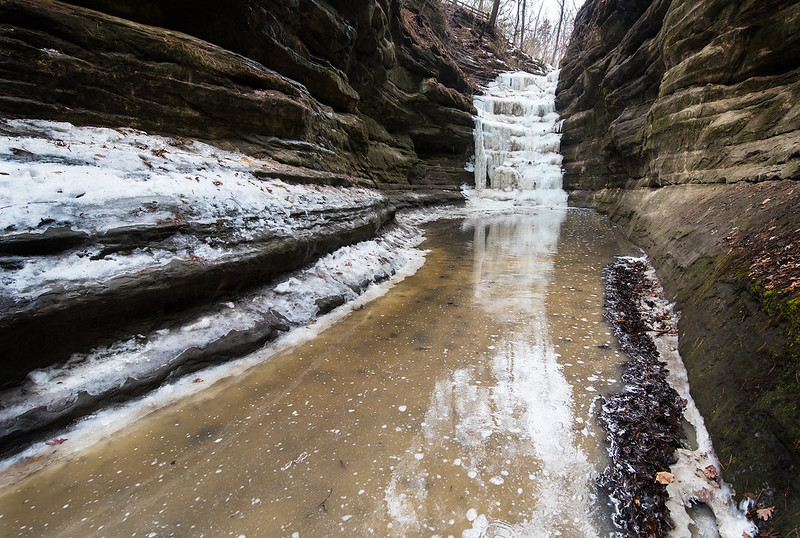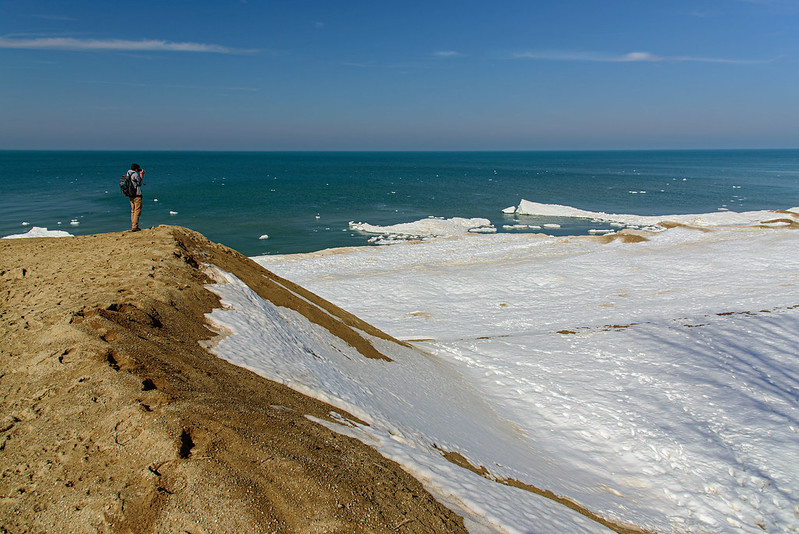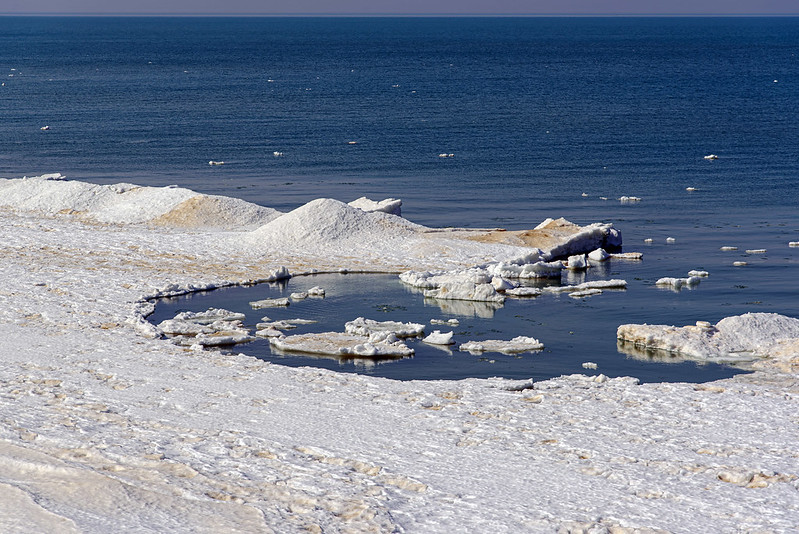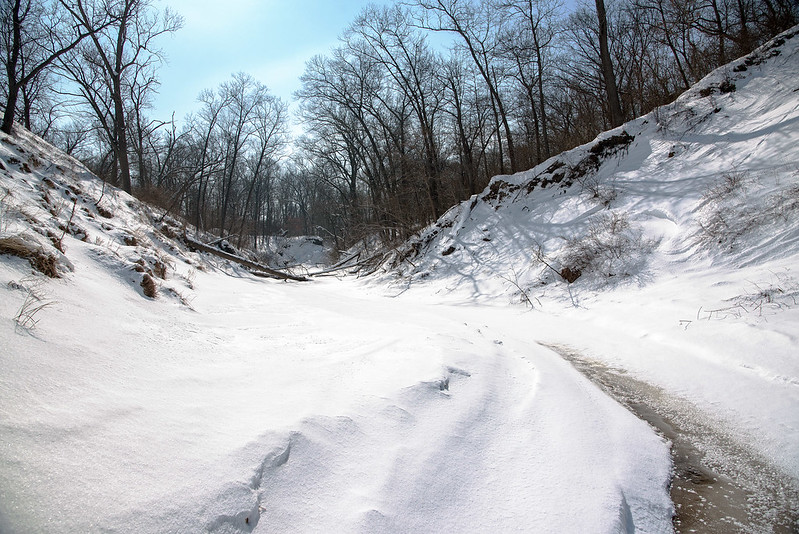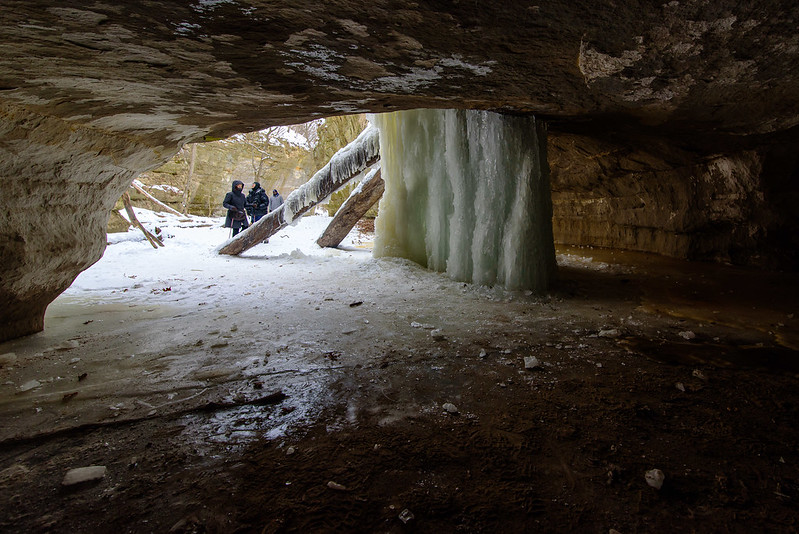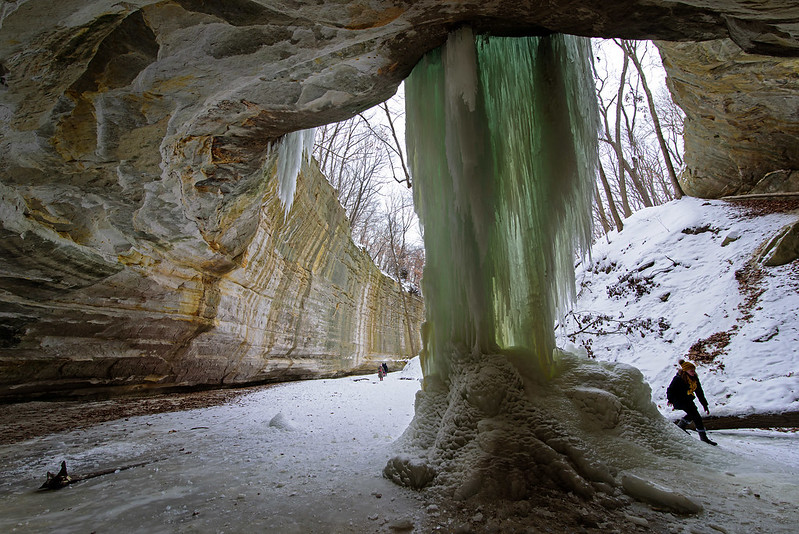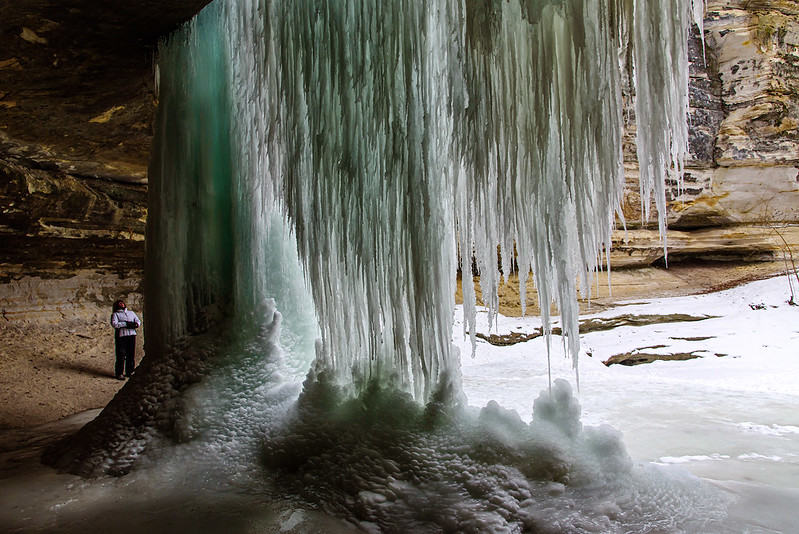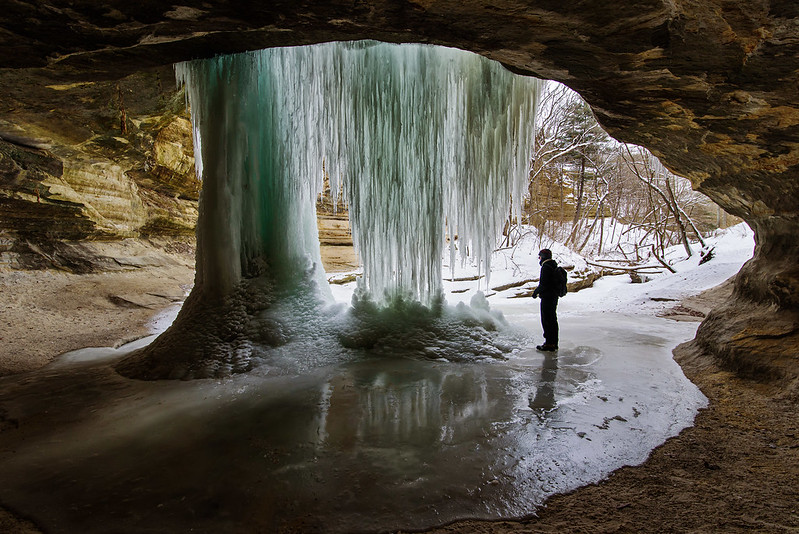I've changed the address of my photo blog. You should be automatically redirected, but if not here is the new address:
Lake Falls

Not only is the ice melting, but to get to the frozen waterfalls is much more difficult if you wish to stay warm and dry. The paths for at least two of these falls were under at least a foot of flowing water. We decided to visit them anyway, and walked through the cold water; our feet were cold for about 10 minutes as the 35 degree water flooded our boots. But after that, they remained a rather comfortable temperature as our body heat warmed up the water in our boots. Even if our feet stayed cold, it was worth the effort to see these falls once again.
Frozen French Canyon

These waterfalls tend to stay frozen for a bit longer than the fragile falls in LaSalle Canyon because they're thicker and in more shaded canyons. French Canyon is one of those very shady locations and generally doesn't have a huge amount of water flowing into the canyon. A heavy flow of water quickly melts the ice formations, while a more gentle one cascades over, under, or around the ice.
This canyon is generally a bit tricky to access when the stream is flowing (if you don't want wet feet), but in winter, it's extremely slippery and difficult to access. Park staff at the visitor's center have told us time and time again that it's not worth even trying to get into French Canyon in the winter - it's too dangerous. The stream flows directly on the portion of the canyon floor that is used for walking, so plenty of ice forms in this area. Without ice cleats on your boots, it's next to impossible to safely walk up into this canyon. Because we've been here many times before, we had our cleats with us.
Every day the warm weather eats away at the ice in all 18 canyons of Starved Rock, so if you hope to see some frozen waterfalls, it's best to visit very soon, or you will need to wait until next winter. Bring ice cleats even if you think the trails are clear - you will need them - sometimes into April.
The Thawing Shelf Ice
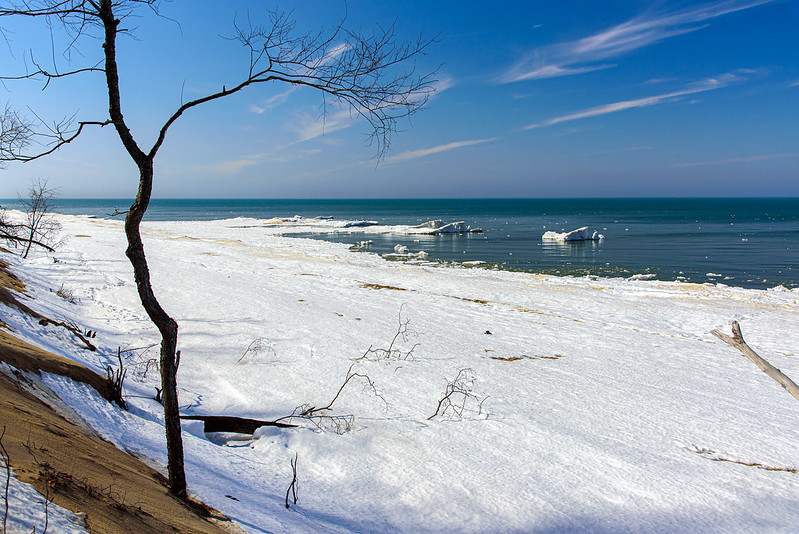
The Snow Covered Trail
Following our walk along the beach, we headed up to an old trail that led to the top of one of the dunes near Kintzele Ditch. An old road leads to the trail, and while the walk is generally easy, our trip this time was a bit more difficult due to the knee-deep snow we needed to move through. Not terribly bad on the flat areas, but up the dune was more strenuous, especially near the top where the snow piled up in tall drifts.
We couldn't imagine not working our way through the snow when we came so far already. Putting out quite a bit of effort in the sunny, 15 degree Fahrenheit weather actually made us sweat. Jackets open, hats and gloves off and we were ready to take on the snowy dune for what I imagined would be a great, winter view of Lake Michigan. We were not disappointed.
Still, even if we didn't make it to the top, just being in the woods after a heavy snowfall was good enough for us.
Hidden Creek

Frozen Kintzele Ditch From the Ground
The heavy snowfall covered the beach and much of the ice covered Kintzele Ditch as it winds through the sand and empties in to Lake Michigan. The view from above couldn't show the depth of the snow and the snow drifts, but the view from the sand shows the snow a bit better.
The creek cuts through the sand and creates a three foot deep cut in the sand, the snow drifted over the ice and cuts, hiding the deeper areas. If one would keep walking, they most likely would end up in snow above their waist! This particular area changes daily sometimes - especially in summer where the waves move the sand and change the direction of the creek. The ice and snow in winter protect the shore from these changes, so for now, Kintzele Ditch will maintain its current flow to Lake Michigan.
Heavy Snowfall on the Lakefront

Our hike began about 1/2 mile away, and once down the slippery dune to the beach, we realized just how much snow actually fell over the past couple of weeks. On average, the snow was past our knees as we made our way toward Kintzele Ditch, in a few places it was shallower, but in others, well past our knees. With all the snow, it was difficult to see exactly where the shore was, so we were careful not to walk out onto the shelf ice. Knowing the area very well, we could estimate and stay safe.
When we reached Kintzele Ditch, it too was iced over and covered in snow. The path of the creek can change daily, so we needed to walk where we knew solid ground was beneath us. If you look closely, you will see our footprints in the snow, walking up to the creek then turning toward the dune. We were able to get to the trail up the dune a bit later. It's an old road that has been abandoned for years, and the snow here was even deeper in spots - up to our pants pockets. That made the walk up pretty difficult and slow, and we questioned if we should try to walk up, but once at the top, we were treated to the scene pictured above. Ice and snow as far as the eye can see on frozen Lake Michigan, and drifted snow all across the dunes and beach. The image is a panoramic image made from three images stitched together.
Kaskaskia Canyon Icefalls
T This waterfall isn't very tall, but the two logs that were washed down the canyon during some past flood add a lot of interest to the image. Behind the fall is a cave that we usually don't venture into because of the story I heard from a friend who fell through the ice here into the water below that was up past his waist. On this visit, we noticed several other people walking around that area, and with the two weeks of very cold temperatures, we knew the ice was thick enough to support us.

While typically not a canyon for ice climbing, I have seen a few people climbing this icefall in the past, and this year, a family with climbing gear and helmets were approaching was we were leaving. I would think this is a good fall to climb for beginners, and also for experienced climbers who don't have the ability to fasten lines to the trees above. This fall would be challenging enough, and if you did slip, you wouldn't fall 80 feet to the canyon floor.
On To Icy Ottawa Canyon

The Ice Column

This winter, at least at this point, only one of the waterfalls was frozen completely, the other consisted of icicles hanging from the top of the rock wall. Given a few more weeks, this too will become a complete ice column. The shape of this icefall reminds me of the Native American Thunderbird, with the two wings of ice on either side. Given the area's history, this seems to be an annual spiritual reminder of this Native American presence.
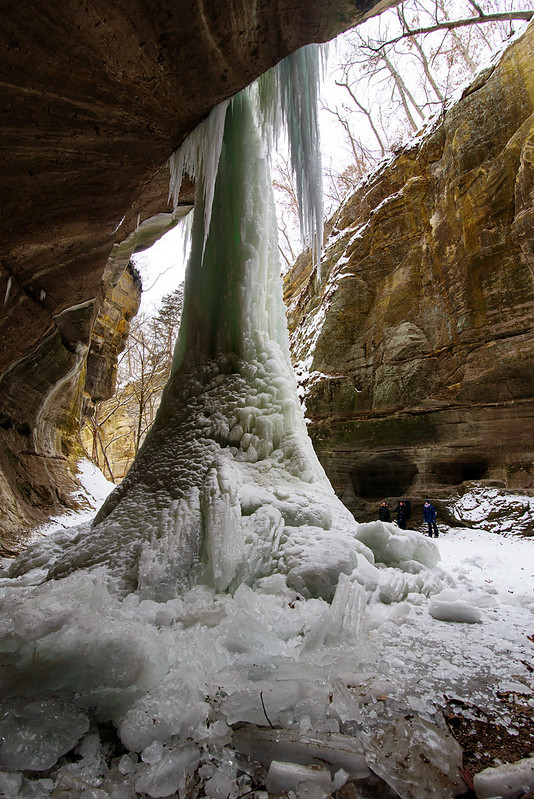
As we explored the frozen waterfall, a group of ice climbers began staging their gear to climb the icefall. Permits are required to climb the waterfalls, and as I found out days later, Tonti Canyon is closed to visitors. We did not see a sign on our way in as we followed the tracks in the snow from LaSalle Canyon, so perhaps the closed notice was outdated on the website.
The Backlit Icefall
Not only was the day very cold, it also lacked sunlight. I'm a rather unusual photographer, I prefer sunlit scenes. In general, most photographers prefer the flat light from an overcast day, it reduces the harsh contrast between bright and dark. But I would rather work through those difficulties while enjoying my time outside.
Sunlight in this case, may have brought out some interesting colors in the ice. The blues of the sky and the greens of the moss would have probably produced some great effects in the backlit ice. But, I will take what I am offered - this scene is how I encountered it, I'm not waiting for the planets to align to capture an image!
It's difficult to tell just how large this waterfall is without some sort of known object near it for some scale. People not only add interest to the image, they offer a sense of scale. That's one of the benefits of hiking with someone, they can be used for scale! Plus, we can compare images later to see each other's take on the same subject.
It looks as if these falls will only get larger in the next week, then perhaps they will take a bit of a beating from the expected 35 degree temperatures next weekend. They certainly won't break apart completely, but they may show some wear. The melt water and rain - if it gets cold again at night - will make the ice grow larger and larger.
The Frozen Waterfall of LaSalle Canyon
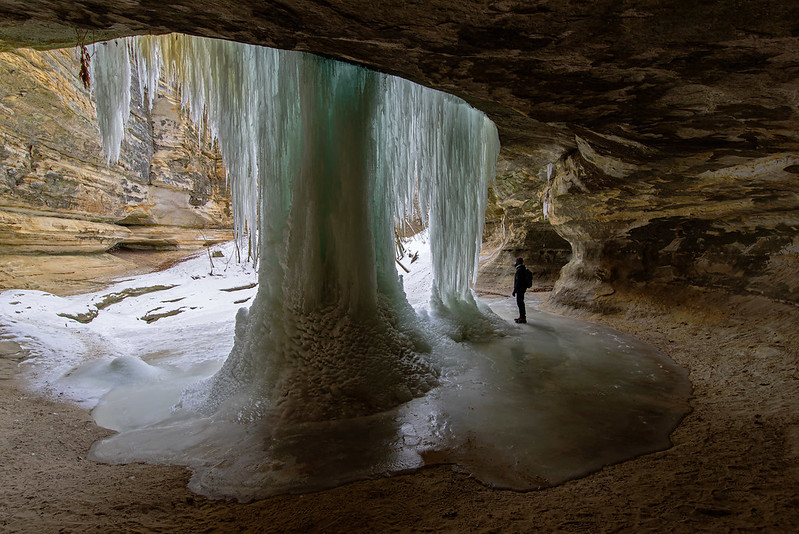

Winter Expanse

The lakeshore can be a lonely place during the winter. Not many people visit, and those who do, tend to stay close to the parking areas and simply walk out and take a photo, then walk back. To get the best view of the lake, you need to climb a dune. Most dunes are off limits, but there are a few where visitors are allowed to follow the trails up.

We followed the narrow trail along the ridge of the foredunes to get to the tallest dune in the area. The trail is challenging enough in the summer months, but the ice and snow made it a bit more difficult on this day. The snow also hides the trail in some places, so you have to look ahead to make sure you're still on the correct trail - not that you'll get lost, but to protect the plants growing in the area. This time we were lucky to find another person's foot prints on the trail; maybe a park ranger.
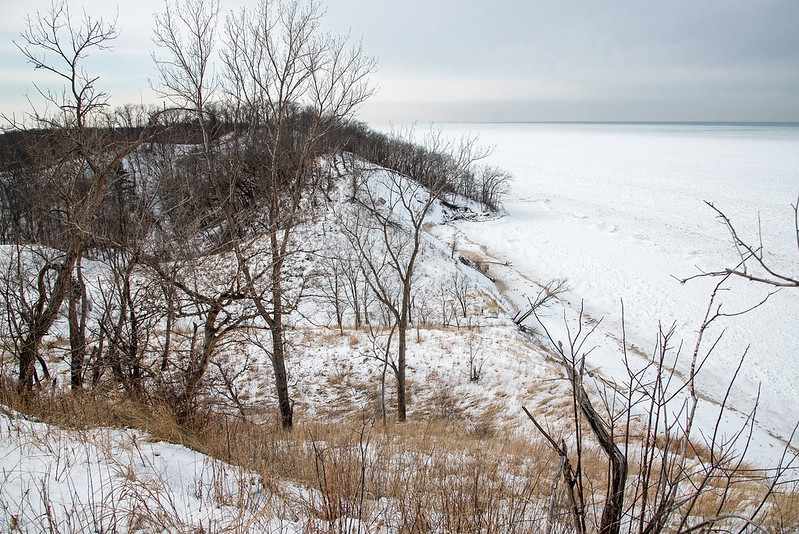
Once at the top, we were treated to the best view of Lake Michigan in the area. I would approximate the height of the dune at 80 to 90 feet, but perhaps it's a bit taller. It's often difficult to tell how high up you are when you see the lake below, things tend to compress visually, but here we could see the ice did not quite go to the horizon, and the Chicago skyline was in the distance across the lake.
From Liquid to Ice in a Matter of Days

Just a week of very cold weather was enough to turn Lake Michigan into something that appears to be in the arctic. The floe ice has gathered at the shore, and some shelf ice "volcanoes" have also formed, transforming the waterscape dramatically. From approximately the same place - just with a different lens - I captured the change the beach has undergone in only a few days.
The image below was taken two weeks prior to the image above (yet actually the beach looked exactly the same one week prior).

The Indiana Arctic
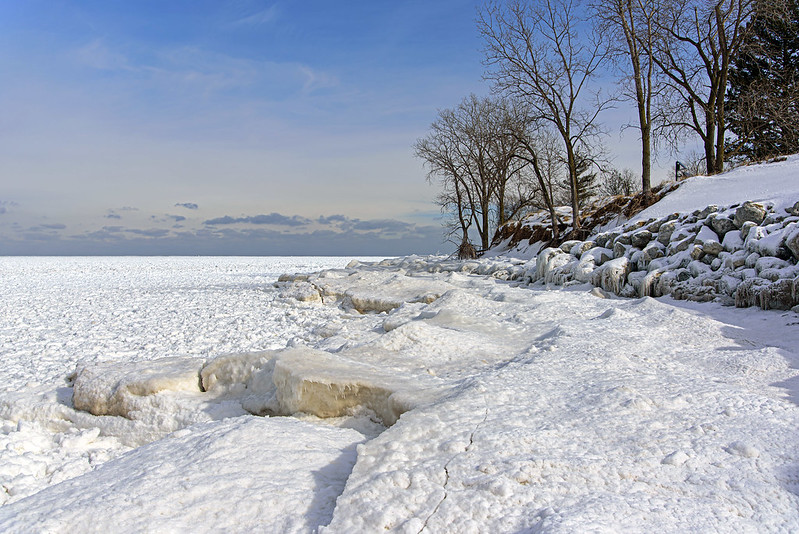
Not technically, but it sure does look like the Arctic at this time of year. Just seven days before, there wasn't a bit of ice at this location, only cold waves crashing on the beach. A few days of sub freezing weather (including three around zero) and Lake Michigan turns into something from another part of the world. On this morning, we were treated to bright sunshine, which illuminates the flow ice, contrasting it against the dark sky. More snow was on its way later in the day, and the approaching clouds can be seen on the horizon.
This is the point at Lakeview Beach Access, part of the Indiana Dunes National Park. It's the easiest access to view the beach - especially in winter. Park your car, and walk about 60 feet to the rail that overlooks Lake Michigan. This year, the path down to the beach is closed, so the view is limited to the patio area, you can't venture down to the sand. Before stopping here, we walked along the beach from the Dunbar Access to enjoy the ice close up. As we arrived at this point, we dared not go any further, erosion has eaten away at the sand on the point, so we weren't going to gamble and walk on the shelf ice. We walked back and drove up later - only to find the beach access was closed. Good thing we walked a few block on the frozen beach.

The view from the Lakeview Access patio is elevated, giving a higher vantage point of the icy lake, but a bit obstructed by trees. One of the better views is just down the path to the right, where you can look almost all the way to Central Beach - about 2 miles down the shore. That would be our next stop; Central beach is finally open after a long period of closure due to erosion and washroom renovations. The climb down to the beach at Central Beach is steep, and the climb up, is much more challenging. This will be corrected by waves over the winter, and bulldozers in the spring. Still, it's certainly worth the effort to view the beach in winter.
Surrounded by Ice

Still, there's something about the hike to the end of the icy pier that attracts me to the lakeshore every winter. If you haven't been to the shore of Lake Michigan in the dead of winter, make this the year you start the tradition. There are many areas where you can safely bring the entire family to view the frozen lake, some only 100 feet from the parking lot. We enjoy these access points too, but if you get down to the beach and hike a mile or two on the shoreline (on the sand NOT on the ice), you will be treated to a lonely, barren, beautiful landscape that is unlike anything you've experienced. And, most times you will not encounter another person in your entire field of vision, so stop, look around, and listen, take it all in.
Building Shelf Ice

Temperatures have finally dropped enough to begin the ice building process on the shore of Lake Michigan. While only in the 20's, the ice still builds slowly, but later this week, temperatures are expected to drop to single digit highs - perfect for building plenty of ice! Climbing a bit up the dunes for a better view of the beach, you can see the extent of the shelf ice along the shore. It hasn't extended into the lake very much, but from this 30 foot tall dune, you get a different perspective of the shore.

Lower down on the beach, the details of the ice are more evident. We were lucky enough to visit at the early stages, so we could actually walk out a bit on some of this ice. You can actually see the shore to the right, meaning this ice was formed when there were high waves, and the ice was deposited a bit above the normal waterline. If the ice extends any further, we wouldn't dream of walking on it.
The Shelf Ice Begins to Form
Here as the ice begins to form, you can see shelf ice (the ice that attaches to the shoreline that can build tall mounds over time), floe ice (the ice pieces floating in the water), and pancake ice (round formations of floating ice that are created by the constant bumping around of the chunks of ice). This is a great time to see just how these formations are created, and it's still safe to go near the shore. While it's never safe to venture out onto the shelf ice, here, the shelf ice is still mainly only hills of ice on the sand that touch the water. However, the ice that is in the water - even if it seems to be sitting on the bottom of the lake - can be very dangerous to walk on. Stay off!
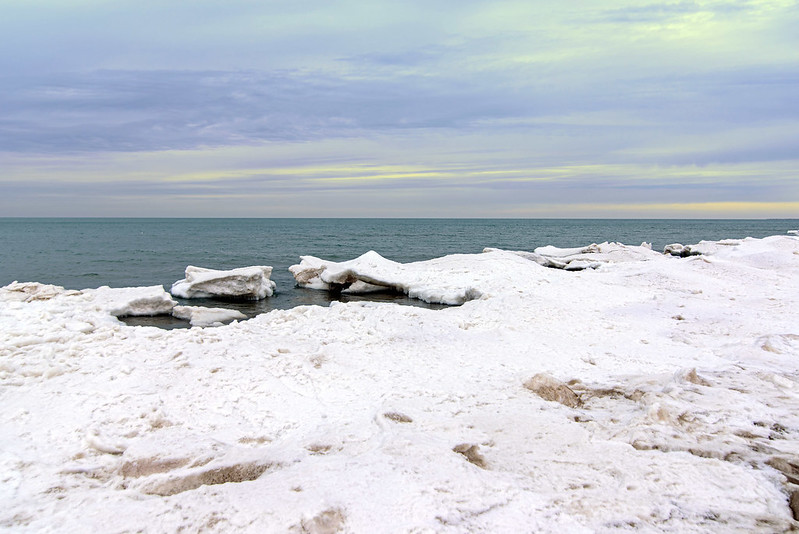
Even though the ice is just forming, there are still large chunks of ice out in the lake, and many of them are beautiful on their own. It will be interesting to watch these formations grow and change over the next few weeks. If the temperatures remain below freezing, and the winds keep pushing the waves and ice toward the shore, the shelf ice can grow relatively fast. High waves will pile the ice up to 10 or 15 feet in hight, creating ice volcanoes, cone-shaped mounds where the center is hollow and water is able to push ice to the surface where it piles up - similar physics as a volcano mound. After a few weeks, these ice fields can extend hundreds of feet into Lake Michigan. Coupled with floe ice and more storms, they can reach as far as the eye can see, making a beautiful arctic scene right here in the Midwest.
Dimple Dune

At the very end of Central Beach, a relatively tall dune stands guard over Lake Michigan. Dimple Dune offers one of the best views of the entire beach, mostly because of its location. Most of the dunes in the park are closed to hiking, and the paths are well marked "keep off," but this dune has an old road system behind it, making it relatively easy to access without damaging any plants or dunes. Climbing on the loose sand of a blowout (portion of a dune with no vegetation that has eroded away) can accelerate the erotion process, so we always stay clear of such areas. Even when hiking a marked trail, we make sure not to step on any plants - marram grass does not tolerate trampling.
From Dimple Dune, one can see many miles across Lake Michigan, including the Chicago skyline, and even into Michigan. Looking behind the dune, the vast areas of LaPorte and Porter Counties can be seen high above the treetops. Several old homes used to stand in this area, along with a few streets that are still evident today. The homes were razed just a few years back; I can only imagine being lucky enough to live right on these dunes.

Looking down onto the beach, we can see where we stood just moments prior, on the frozen shore of the small cove filled with logs, boulders, and ice. It appears rather small from this height, but those trees are full size, some over 40 feet in height. Looking at the top photo on this post, for a sense of scale, look along the beach in the shadow of the dune toward the top of the photo, you will see two people walking on the beach. Their size should give you an idea of the size of the sand dunes along this shore of Lake Michigan.
